Weekender 1/19/18

Weekly News Recap
- Allscripts-hosted EHR and e-prescribing systems go down early Thursday due to a ransomware attack.
- DoD confirms that its Cerner rollout is on hold not because of problems, but rather according to the original project plan, which called for a comprehensive review of the first four pilot sites that won’t be completed until later in 2018.
- Change Healthcare acquires National Decision Support Company.
- Microsoft kills its HealthVault Insight app less than a year after its rollout.
- Senator Jerry Moran (R-KS) questions the VA’s contract-signing delay with Cerner, asking in a letter to Secretary David Shulkin what he hopes to learn or do differently after digging deeper into Cerner’s interoperability capabilities.
- The VA’s CIO says its legacy VistA system will need to remain running (and funded) for the 10 years it will take it to fully implement Cerner.
- Hancock Health (IN) pays the demanded $55,000 ransom to regain access to its systems following a ransomware attack, saying it was a good business decision given the time it would have taken it to restore them from backups.
- The CEO of Fairview Health Services (MN) calls for a “march on Madison” to demand that Epic encourage innovation by opening up its system and intellectual property management practices.
- McKesson, 70 percent owner of Change Healthcare, says Change’s IPO could be run this year.
Best Reader Comments
Epic’s model does assert the ability to use any IP in App Orchard without compensation or limitation, it’s why the few vendors I’ve spoken to are hesitant to use it. The only reason that they’re considering it is because Epic has a stranglehold on their customers. That atmosphere isn’t really innovation-encouraging. (DrM)
Amused by the fact that the most engagement an HIStalk post has received in months is due to a hospital executive saying something critical of Epic. Thin skin in Madison. Epic is Big Healthcare. With that kind of company financial success, you are going to have your critics. Comes with the turf, guys. (CheapSeats)
There’s a world of difference between updating the OS or AV software, where users shouldn’t be affected at all, and updating software that affects of the UI and workflow of knowledge workers. The number of decision-makers involved is an order of magnitude different, and simply understanding the effects of workflow changes can take far more than three months. (DrM)
So “pace of change and innovation is stifled” and “pace of change in software is too fast”? I’m confused. (Doesn’t compute)
VA CIO: Expect another 10 years of VistA in facilities during new EHR rollout. This is clear indication of how the VA and government agencies are dysfunctional. There is so much wrong with this it’s hard to decide where to begin. Interoperability issues between systems only being exacerbated over years as patients move from a region on Cerner back to a facility still on VistA. How do you call a system new 10 years after it’s installed in the organization? In 10 years the VA and DOD could be replacing Cerner with another system. (Matt)
Will this Cerner dust-up with the DoD now give us a real granular discussion on a national level as to what Interoperability really means as far as how much is exchanged, degree of exchange and access, and who is responsible for it ($$$$ from vendors or hospitals paying for the infrastructure)? More realistically, will it force Cerner deeper in to a “commitment” to the CommonWell Health Alliance? Commitment in quotes means a lot of things. Really publicizing how well (and how much) it shares between itself and the other vendors and Epic. Having to commit more resources to it, including education and architecture for their customers and hospitals using other vendors. Perhaps how Cerner has to address this could chip away at the conventional wisdom that eventually you will have to be on either Epic or Cerner. (You might say I’m a dreamer)
I played Theme Hospital as a child and always thought it was a joke that the hospital systems were out for profit. Now I write EMR software. It was the longest, darkest punchline.(ThemeHospital)
Epic doesn’t assert ownership over any the apps on their App Orchard or the hundreds and hundreds of third-party apps that work with Epic. Their model is just like Apple. And, if there are literally billions of dollars and so many smart people in Silicon Valley, why didn’t they solve healthcare automation in a hugely, bigly amazingly way by now? They’ve had that money and those smart people for a while. How did a podunk outfit out of Madison Wisconsin get the drop on all of them? Good thing they haven’t found Kansas City yet. Give us a break James. What specific innovation do you feel is being impeded? (What’s with the Fairview guy?)
Even though Apple could take IP directly from the Apple ecosystem developers, their usual model is to just buy the companies. Same is true for Google and Microsoft. The big guys get the IP in the end, but developers get an exit strategy. Because of Epic’s stance against acquiring, that option isn’t available to Orchard developers. I would be hesitant, too. (Bob)
I wonder if there should be an EHR feature where patients if they’d like can subscribe to access to their record where they get emailed every time it gets accessed with a note on who accessed it and their role? (AC)
I’ve stopped believing any story about celebrity doctors saving people on planes unless there’s photographic proof of it happening. Eric Topol figured out it’s a completely unverifiable way of getting extra publicity for whatever device he happens to be talking about at the time, and obviously Oz learned the lesson. My prediction – Oz has a show coming up about the dangers of air travel. Regular doctors respect those peoples’ privacy and don’t go humble-bragging about their clinical acumen. (DrM)
Parental Leave Policy Responses
A few folks responded to Allspice’s question about paid leave for new dads, which his company doesn’t offer.
- Athenahealth – 12 weeks for mom, six weeks for dad.
- Unnamed health system – no maternity, paternity or family leave. Employees have to use FMLA and cobble together PTO and short-term disability if you’ve given birth. “People always assume that because I work in healthcare, I have great health benefits, and I just respond with a slightly unhinged laugh.”
- A reader from Canada – leave policy is mandated by the federal government. New moms get a maximum 15 weeks at 55 percent of average compensation, while those caring for a new child get a maximum 35 weeks at 55 percent of earnings (can be shared between parents) or 61 weeks at 33 percent of average earnings.
- Epic – new moms get 5-8 weeks of short-term disability, then can use PTO to cover the rest of FMLA time up to 12 weeks. They can then come back part-time for another three months, but that’s a problem for those in travel roles. New dads get nothing. “I was back on the road 17 days after the little one was born. They will tell you that they support your time off, but if you have an escalated client, you are responsible for it, period. As a company that preaches about health and doing the right thing, they missed the boat on being progressive on this key area for welcoming a newborn.”
- Merge Healthcare/IBM – IBM increased the paid time for paternity, maternity, and adoption from six weeks to 12 and even back-granted extra time for new parents.
- Unnamed health system – women get short-term disability and FMLA (no specific paid maternity leave) and dads get FMLA.
- Epic – no paid time off, just FMLA.
- Unnamed health system – introduced a new benefit of two weeks PTO for both parents with a birth or adoption, Previously, dads got PTO/FMLA and moms got short-term disability after a two-week waiting period.
- Unnamed health system – new dads get nothing outside of FMLA, moms get short-term disability if they give birth and only FMLA if they adopt.
- WebPT – for birth, surrogacy, adoption, or foster care, no benefit for less than six months of service, two weeks time off for 6-24 months, four weeks for two or more years of service. Employees get two weeks for foster care.
Watercooler Talk Tidbits
Thanks to those impressively credentialed readers who signed up for my Rolodex – I really appreciate it. The link will always be listed at the bottom of the Weekender posts, along with links to other permanent and short-term opportunities to help me out or get involved. It’s heart-warming to see CIOs, other hospital executives, CEOs, technologists, consulting firm executives, and clinicians offer to provide me with occasional guidance and news reaction.


HIStalk readers provided science game night activities for the elementary school class of Mrs. S in Mississippi in funding her DonorsChoose teacher grant request. She reports, “Thank you so much for helping my students fall in love with science. It warms a teacher’s heart when they actually want to learn! They were so eager to see the new products that we got to use for our projects. Their favorite one so far has been the Augmented Reality dinosaur project. They just love that they can make it come to life with just the use of an iPad. I cannot wait for my students to use the globe next. That is our next standard in science. They will get to learn all about the seven continents and ‘see’ them just as if they were there.”

The fun folks at Ellkay sent cool swag our way through Lorre. I thought the “15 years” mug was to commemorate HIStalk’s 15th anniversary (this coming June), but I realized in rotating the mug that it refers to Ellkay’s 2002 founding. Inside the cool cardboard container is some Ellkay honey supposedly harvested from bees kept on its roof, and even though I can’t verify its source, it’s still a great marketing idea.
A few readers let me know they got an error trying to read HIStalk Thursday afternoon. It was actually a good problem if there is such a thing – so many folks jumped on to read my Allscripts ransomware news item (to which kind readers alerted me) that my dedicated, rather high-powered server was overloaded for 30 minutes or so. Thursday didn’t set a readership record since, other than the Allscripts item, I hadn’t published anything except headlines and Dr. Jayne since Tuesday night, but it was still over 11,000 page views in a 24-hour period. Tops of all time was DoD’s Cerner announcement day, July 30, 2015, when 17,000 folks checked it out and many others weren’t able to get in, leading me to dig out my wallet to beef up the hardware yet again.
Uber hires a HIPAA-focused lobbying firm for unstated purposes, but possibly related to transporting people to medical appointments or for professionals booking rides for patients.
“The Resident” premieres on Fox Sunday night following the NFC championship game. It’s apparently cynical and darkly funny in covering healthcare ethical issues, an incompetent surgeon bullying staff to cover up his mistakes, and the never-ending quest by hospitals to boost their bottom lines.
In Case You Missed It
- News 1/19/18
- Ransomware Attack Takes Down Some Allscripts Systems
- EPtalk by Dr. Jayne 1/18/18
- News 1/17/18
- Curbside Consult with Dr. Jayne 1/15/18
- Monday Morning Update 1/15/18
Get Involved
- Join my Rolodex to provide occasional news reaction or ideas
- Contribute regularly as a provider CIO, IT director, or informatics nurse (anonymous or not)
- Be interviewed (providers)
- Deliver an educational webinar (providers)
- Sponsor
- Report a news item or rumor (anonymous or not)
- Sign up for email updates
- Connect on LinkedIn
- Contact Mr. H




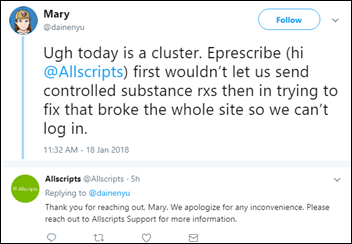
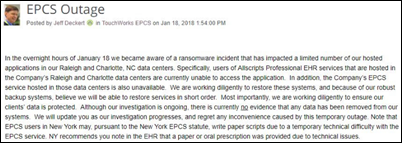






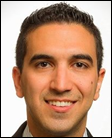




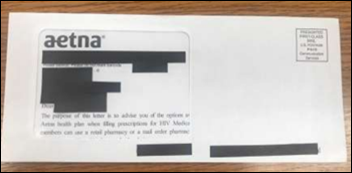

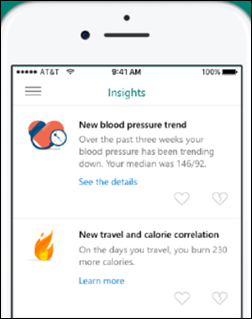

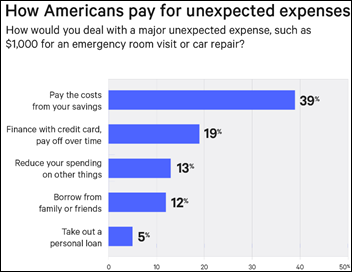



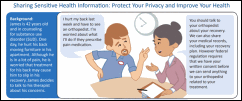
























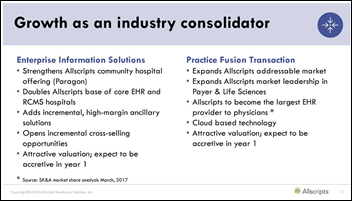





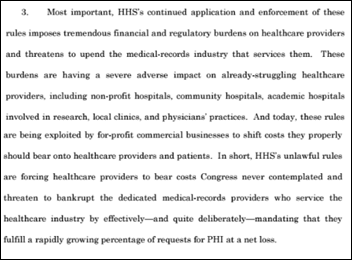




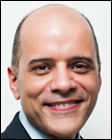




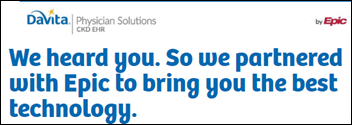


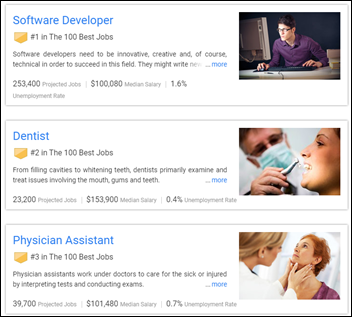
Teens will certainly find a way to use their social media apps of choice. I'm not in favor of the…